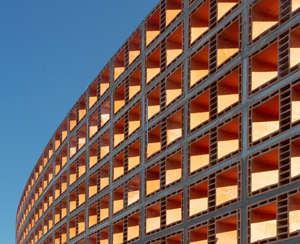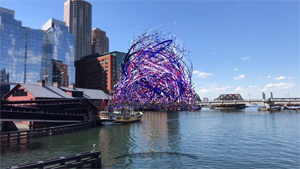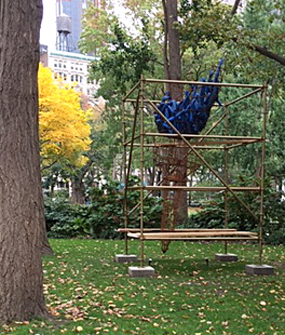Late for Summer
John Haberin New York City
Héctor Zamora, Nancy Baker Cahill, and Abigail DeVille
Summer sculpture can be more than a feast for the eyes. It is also a terrific excuse, should you need one, to explore the city. After Covid-19, New York itself seemed in retreat, but take heart. Some were not party poopers after all. They were just late to the party. Summer had become virtual or fall.
Every so often, I can almost pity Donald J. Trump. Not only is he doomed to one term by massive deaths, mass unemployment, and malfeasance, but he never could carry out his most outrageous promise, the wall. He should have gone for help to Héctor Zamora. True, one could not meet for a drink on the Met roof in the shadow of his wall. But it adjusted to its site as if nothing had happened along the way. Settle right in. 
So how did you celebrate July 4? Did you enjoy a weekend at the beach—your first, if you are a New Yorker, since the lockdown? Or did you reflect on an ideal of liberty broader than a beach towel? Nancy Baker Cahill would encourage both, for anyone with a mobile phone and a love of travel. With Liberty Bell, Cahill lets freedom ring across eastern America, where it all began. She pictures the Liberty Bell still ringing and still haunting historic sites, but also on the verge of dissolution.
But is that enough, and just whose freedom rings? In answer, Abigail DeVille appeals to another treasured symbol, the Statue of Liberty, and to Frederick Douglass: "if there is no struggle there is no progress." I hope that it will not trivialize Douglass and African Americans if I also think of how hard it is to make art. I hope, too, that it will not trivial an artist who is still pinning down the struggle, in Madison Square Park. I report separately on Frieze Sculpture—along with the fate of art fairs after Covid-19.
Walling in the view
Maybe Mexico will not pay for this wall, but a Mexican artist conceived it, and it is a beauty. A museum wall does not often reward attention, as other than a place to hang art. Nor is many a wall so open to air and light. A wall might seem a failure if it were, but Héctor Zamora plays against expectations for art and architecture. One comes to the Met roof for summer sculpture, but also for the view of Central Park and maybe a drink. Instead, coming off the elevator, one has nearly a bare platform for a curved wall, close to its length and eleven feet high.
Not that Zamora got his wall built on time either. It opened to the public barely a week before Labor Day, like the museum itself. Covid-19 also removed the bar, but the artist adapted. His work just grew longer. Past artists tried free-standing sculpture like Alicja Kwade or Huma Bhabha, overrun the roof like Mike and Doug Starn, or barely touched its paving stones like Pierre Huyghe. Lattice Detour is looming but site specific.
One can hardly overlook its mass. Hedges atop the low exterior walls already cut back on the view, no doubt for safety, but not like this. Its curve recalls Tilted Arc by Richard Serra—designed to cross a public plaza until the public objected. And it recalls Serra's imposing walls while mocking their threat to crush anyone who dares to approach them. Still, it reflects how those walls also nestle viewers by leaning over and away. Where rust tempers their steel black, Zamora makes use of brick's warm reds, with materials from his native Mexico.
They present textured white cells broken halfway through for vertical ripples. Up close, one can see how he does it. The white amounts to cement between bricks, and the ripples are the latticed brickwork, which frames each brick as well. Up close, too, one can see right through the wall, for the rest of its space is empty, leaving pockets of sunlight. Sure enough, the park is there, in all its glory. Stand back again, this time facing the wall, and the Upper West Side and greenery return as a single picture.
The panorama emerges intact on a "lattice detour" to the far side of the wall. So in late morning does the wall's shadow, itself both optical effect and mass. Late afternoon, as the sun appears in the sky to the west, the shadows move to the wall's more sheltered side and become more latticed, too. I can only imagine the sky through the wall at sunset. It might look better still after a drink, but art after Covid-19 is all about disappointments and sacrifice. Still, it testifies to how much material and optical presence is lost in "virtual exhibitions."
Zamora means the work as time as well as site specific. He has worked before between architecture, installation, and performance, to political ends. He created a museum extension and lived in it, like the homeless that the Met excludes, and built at both rich and poor ends of a single street—much as the Met graces Fifth Avenue while taking over more and more of a public park. He also has in mind the lattice in traditional Latin American art or African art. Yet a lattice appears, too, in the white shutters that always decorate the roof. Unlike Trump's wall, this one is responsive to its neighbors and not altogether futile.
Virtual lands of liberty
Art faces other conflicts, too, besides pleasure and understanding. Galleries are reopening, but with all sorts of restrictions. Nancy Baker Cahill works in conjunction with 4thWall.org, a project of the Art Production Fund. Download its app to an iPhone or tablet, turn on cellular data, and head to one of six locations. You will be aware of the trek and their physical presence every minute. This is not virtual but "augmented reality."
 Maybe you were not exactly in the mood for a celebration, what with millions out of work and police racism and murder. But then the Liberty Bell developed a crack early on, and it has not rung out since before the Civil War. The sites, in turn, embody competing visions of liberty. They include the Washington Monument, the spot in Boston for a Tea Party, and a bridge in Selma whose crossing meant so much to civil rights. They also include Fort Sumter, where the Confederate states brought on the Civil War, and the "Rocky steps" of the Philadelphia Museum of Art. New Yorkers can settle for the Rockaways and a monster beach.
Maybe you were not exactly in the mood for a celebration, what with millions out of work and police racism and murder. But then the Liberty Bell developed a crack early on, and it has not rung out since before the Civil War. The sites, in turn, embody competing visions of liberty. They include the Washington Monument, the spot in Boston for a Tea Party, and a bridge in Selma whose crossing meant so much to civil rights. They also include Fort Sumter, where the Confederate states brought on the Civil War, and the "Rocky steps" of the Philadelphia Museum of Art. New Yorkers can settle for the Rockaways and a monster beach.
Make the journey, point your phone, launch the app, and with luck an animation will begin, with sound, running about ninety seconds. A huge bell swings gently back and forth over the reflecting poll of the Washington Mall or Boston harbor, as if ringing. It dissolves into a tidal wave of red, white, and blue over the Atlantic Ocean or Jamaica Bay—between Far Rockaway, a long peninsula off Brooklyn and Queens, and the mainland. Cahill fashions it from colored strips, like patriotic confetti. The site also contains a handful of abstract drawings, which launch further animations. The artist, who speaks about learning to see art as more than a canon of male genius, is asserting her freedom, too.
The Rockaways version has four parts, with its own arduous journey. One might start just to the left of the NYC Ferry landing, looking back over the bay. Just in case the ferry from Wall Street has insurmountable lines, the subway past JFK airport stops only a few blocks away. (I faced a more than two-hour wait for the hour-long trip that holiday weekend—and resolved to try again the next day by train.) Crossing 108th Street to the ocean (or a hotel rooftop in-between) offers a second view of art, liberty, water, and sky. A third incarnation faces a concrete ruin in Fort Tilden, where a neighborhood artist's collective holds court and where Katharina Grosse and Yayoi Kusama installed work previous summers.
All this takes patience. Expect a ninety-minute walk east, past the community and beaches, the fort's scattered buildings, and a rundown park, on top of the ninety-minute subway to Queens. It ends in a seeming dead end, on an unmarked gravel road, before another walk back to a bus to the subway—with, I can safely promise, a few more wrong turns along the way. The fourth location, in Shirley Chisholm State Park, is if possible even more remote—not to mention back in Brooklyn. (A California artist may not think in terms of mass transit.) The good news is that race enters once again, for the park commemorates the first black congresswoman.
For me, it was also frustrating. The app never sensed my location, so I never saw the the work. I tinkered, reread the directions, and tinkered again—long enough to drain the battery, and the phone died. I braved the summer heat to case out the remaining stops over the course of a week, and I still have no idea what went wrong. The app even tried to convince me that I was on Liberty Island, the site of a former 4thWall project and the Statue of Liberty. For once, one might settle for a virtual exhibition in the comforts of home, but I have a year, and I am determined to try again.
The flame and the lightning
Frederick Douglass was not just accepting the burden of struggle against slavery, with all its uncertainty of success. He was demanding it, in the face of those who would call for freedom while deprecating "agitation." For Abigail DeVille, too, not every burden is heavy. She quotes Douglass to accompany her sculpture in Madison Square Park. She is calling for action on behalf of freedom, but she might well be speaking of the unfinished business of art. Her Light of Freedom might seem at first yet to arrive.
You may seek out DeVille, like past artists, in the park's great lawn, only to find it empty but for a family or two—or fenced off for winter. Liberty lies just ahead all the same, in a smaller plot in the winter chill, as if shunted aside like the African American experience itself. The installation rests under scaffolding and behind a fence, just off Fifth Avenue. It would need that scaffolding to remain erect and off the ground. A rusted cage holds little more, it seems, than a rusted bell unable to ring out freedom. The cage broadens slightly at the top, giving out before a larger basket for an unsightly blue mass overhead.
It takes several more steps to make progress. Seen from the south, the cage takes shape as a torch—the torch of the Statue of Liberty. The bell within it might not match the Liberty Bell in Philadelphia (or in "augmented reality" for Cahill) in age, size, or dignity, but that bell has not rung out in some time either. The blue mass takes shape, too, as human arms. They flail every which way with open palms as a plea for life or liberty,  but they ascend vertically like a collective black power salute. From their place in the construction, they are the flame, in what Jacob Lawrence called the American Struggle.
but they ascend vertically like a collective black power salute. From their place in the construction, they are the flame, in what Jacob Lawrence called the American Struggle.
DeVille herself has made rapid progress. She appeared as recently as 2012 among emerging artists in the New Museum Triennial. A year later, she displayed an old TV, an American flag, and a busted shopping cart among some more emerging artists at the Studio Museum in Harlem. She has been asking what it takes to sustain household memories and America's promise ever since. A dry cleaner's rack kept spinning to deliver its dirty laundry at SculptureCenter in 2015. She got trashier still in Socrates Sculpture Park in 2016.
If DeVille has added anything over the years, it is the severed limbs. Mannequins entered another shopping cart, again at the Studio Museum, for "Material Histories" along with Kevin Beasley in 2015. Upturned legs packed a boat for the 2017 New York art fairs. They returned as "detritus" of the Great Migration at Wave Hill in 2019. In each case, they exemplify the struggle, but also the lives at stake. They represent, she has said, a community's "embedded histories."
She has earned a solo act. It comes just in time to gain in meaning from pandemic and Black Lives Matter. If she has to put up with fencing, you would not want people climbing the scaffolding to shake hands. If she risks only adding to the trash, hot male artists have been parading their trash art for some time. Still, the scaffolding makes a bigger impression than the work. The struggle for art is not over.
Maybe it asks too much to see only the flame. "They want rain without thunder and lightning," Douglass said. "They want the ocean without the awful roar of its many waters." He was speaking in 1857, as the roar deepened, and the rains came. DeVille is onto something marvelous, but it could stand a greater heat or spark. Amid the trash and the park, it is not so easy to see the light.

Héctor Zamora ran at The Metropolitan Museum of Art through December 7, 2020. Nancy Baker Cahill ran through July 4, 2021, Abigail DeVille through January 31. Related articles begin the story of 2020 New York summer sculpture and Frieze Sculpture.




